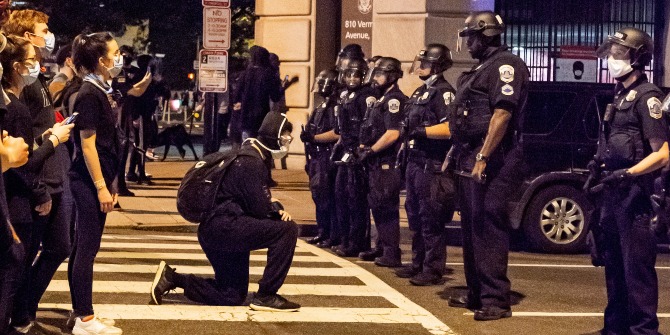 Last week, the Department of Justice announced that it would end its use of private prisons. Brett C. Burkhardt writes that while the move will eventually reduce the number of federal inmates in private facilities to zero, it will have no effect on the 90,000 held in state private prisons, and on Immigration and Customs Enforcement or the US Marshals Service which together hold 21,000 in private facilities. He also comments that one likely response to the move from the private prison industry will be to double-down on contracts for immigrant detention.
Last week, the Department of Justice announced that it would end its use of private prisons. Brett C. Burkhardt writes that while the move will eventually reduce the number of federal inmates in private facilities to zero, it will have no effect on the 90,000 held in state private prisons, and on Immigration and Customs Enforcement or the US Marshals Service which together hold 21,000 in private facilities. He also comments that one likely response to the move from the private prison industry will be to double-down on contracts for immigrant detention.
The US Department of Justice has announced a plan to end its use of private prisons. Last week, the Department issued orders to the Bureau of Prisons to allow extant contracts to lapse without renewal and to cease future requests for new contracts. The plan will reduce the number of federal inmates in private prisons to roughly 14,000 by 2017, down from nearly 30,000 in 2013, and eventually bring the population to near zero. That said, the plan will actually leave the majority of private prison contracts untouched, and is also likely to mean that private prison providers will push even harder for contracts for the detention of immigrants
Private prisons in the US – the story so far
Prison privatization involves a contractual arrangement between a government and a private firm. Typically, the firm takes over all incarceration responsibilities in exchange for a fee from the government. The modern private prison industry emerged in the US in the 1980s. It was fueled by two developments. First, the prison population was beginning a steep and sustained increase that would continue for 30 years. The growing prison population (which coincided with declining crime rates) strained the existing prison stock, which could not accommodate the influx of new prisoners. Many jurisdictions responded by contracting with nascent private prison operators, which operated on a for-profit or not-for-profit basis. The second development fueling prison privatization was an ascendant conservative political ideology. In the era of the Reagan Revolution, policymakers became increasingly suspect of government operations and put their faith in the free market to solve pressing social problems. Private prisons, then, helped meet growing demand for prison beds, and they did so in a way that resonated with the politics of the time.
Since those early years, the private prison industry has increased its “market share.” Private prisons operate in most states, and they hold over 130,000 prisoners: roughly 30,000 for the federal Bureau of Prisons, and the remainder for states. (It should be noted that this large figure only represents about eight percent of all inmates in the US.) In addition to convicted offenders, the private prison industry also detains roughly 14,000 immigrants for Immigration and Customs Enforcement (ICE) and another 17,000 people for the US Marshals Service (USMS). The bulk of the market is cornered by three large for-profit firms: Corrections Corporation of America (CCA), GEO Group, and Management and Training Corporation (MTC).
The industry has come under fire on several occasions in recent years. Riots have disrupted several facilities. Several states have canceled contracts. A movement to divest from private prison investments has emerged. Beyond these flashpoints, a large body of research comparing the performance of private and public prisons has accumulated. While the empirical record is somewhat equivocal, there is no robust evidence that private prisons are superior to their public counterparts. Yet a number of studies have identified deficiencies in the private sector. These studies indicate that private prisons tend to have more escapes, fewer inmate programs, more contraband, less staff training, and higher staff turnover. In particular, the DOJ’s Office of the Inspector General released a highly critical report just days prior to the phase-out announcement, stating that it had concluded that private prisons were less safe and secure than similar facilities operated by the Bureau of Prisons. All of these matters have created a challenging environment for prison privatization.

The DOJ’s order and what it means
The announcement by the Department of Justice ordered the federal Bureau of Prisons (BOP) to phase out its use of private prisons. There are several facets of the decision that bear emphasis.
- The order applies to federal prisons. The vast majority of prisoners in the US are held in state prisons, which are not bound by the DOJ order. Overall, states imprison roughly 1.35 million prisoners, of which more than 90,000 are held privately. Nothing in the DOJ order has any direct effect on this.
- The order is limited, even at the federal level. The order applies specifically to the BOP. However, it has no bearing on Immigration and Customs Enforcement or the US Marshals Service, two other federal agencies that together place around 21,000 people in private facilities. Even within the BOP, the order is limited to secure confinement facilities; BOP is free to continue using private firms to operate its community corrections centers.
- The order will not immediately suspend the use of private prisons by BOP. Rather, the DOJ has ordered the Bureau to allow extant contracts to lapse and to suspend future competitions for future contracts. The goal is a gradual drawdown of contracting, with only three facilities being shuttered in the coming year.
What’s next
Some implications of the announcement were immediate; some are likely to be felt later on. Within hours of the announcement, stock prices for CCA and GEO had fallen 35 percent and 40 percent, respectively. They have since regained some of their value but remain depressed. Representatives from both companies have attempted to mollify concerned investors by playing down the decision and assuring the viability of the firms. As previously noted, the announcement will only directly impact a fraction of existing contracts. Nonetheless, this phase-out is likely to introduce a degree of uncertainty into the market, as it may serve as a model for other jurisdictions that anticipate declining inmate populations or have been disappointed in their own contracting experiences. One likely response from the private prison industry is to double-down on contracts for immigrant detention. Criminal justice reform at the federal and state levels stands to reduce demand for private beds to hold convicted prisoners. Immigrant detention, however, shows no signs of flagging. Roughly 62 percent of beds for immigrant detention are privately operated, and the companies may look to increase these numbers moving forward.
In sum, the Department of Justice’s announcement represents an important symbolic move away from private prisons. While it leaves intact the vast majority of private prison contracts in the US, it may serve as a model for other jurisdictions to reduce their reliance on private contractors in the future, and it signals to investors that the “market” for imprisonment is somewhat less predictable and profitable than it once was.
Featured image credit: BBC World Service (Flickr, CC-BY-NC-2.0)
Please read our comments policy before commenting
Note: This article gives the views of the author, and not the position of USApp– American Politics and Policy, nor of the London School of Economics.
Shortened URL for this post: http://bit.ly/2bwJlyA
______________________
 Brett Burkhardt – Oregon State University
Brett Burkhardt – Oregon State University
Brett C. Burkhardt is an Assistant Professor of Sociology in the School of Public Policy at Oregon State University. He is currently conducting research on the use of private prisons in the United States and has previously written on topics including felon voting rights policies, labor market consequences of felony convictions, and policing.






